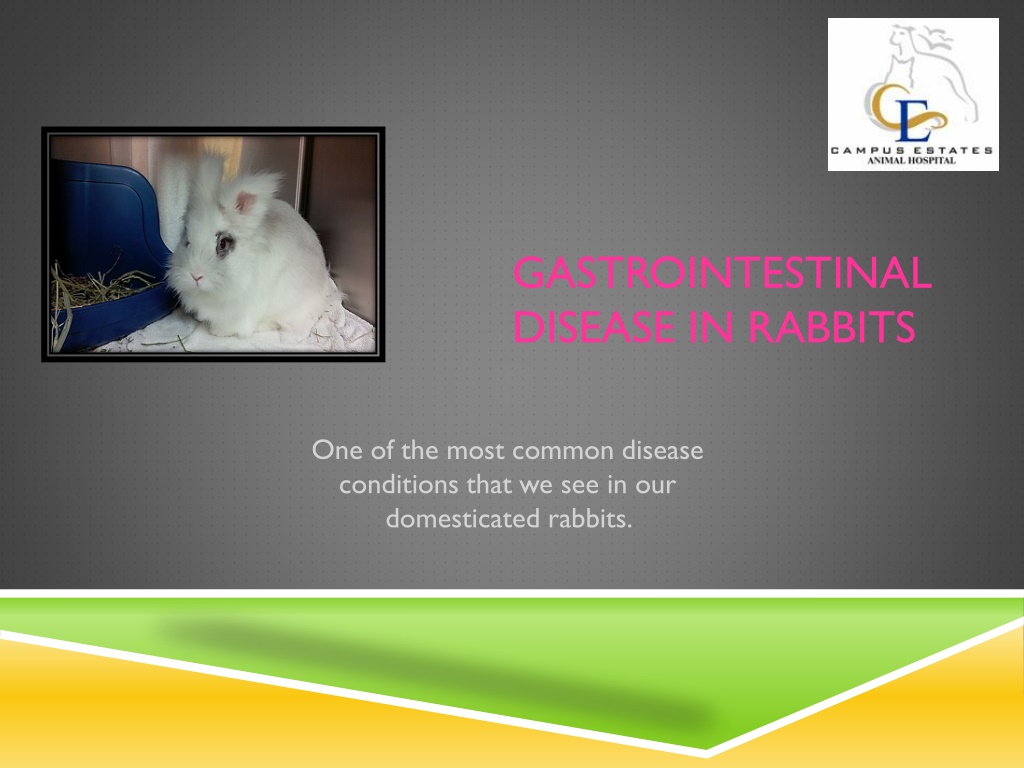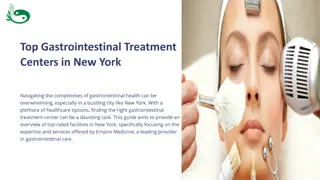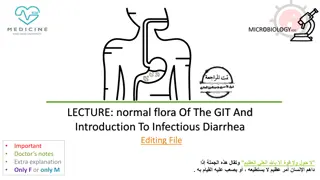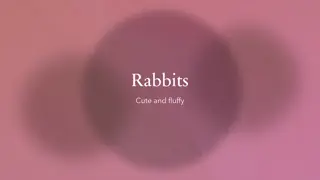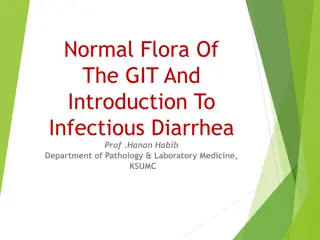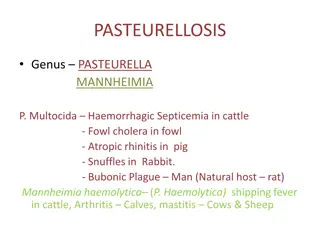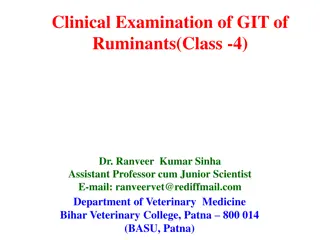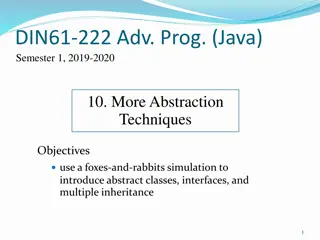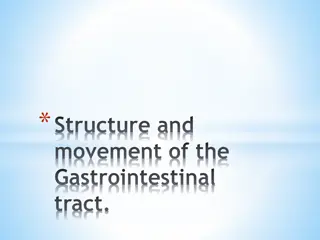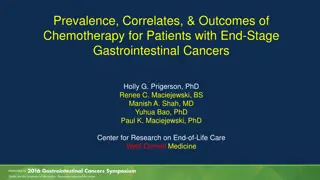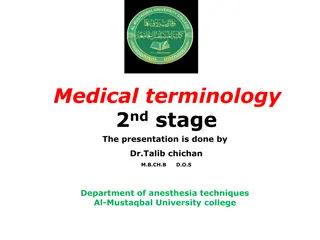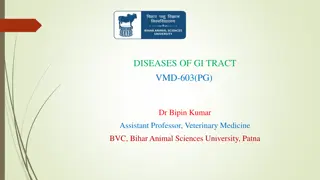Understanding Gastrointestinal Disease in Rabbits: A Comprehensive Overview
Gastrointestinal diseases are common in pet rabbits and can lead to serious health issues. Factors such as decreased motility, bloat, obstruction, and diarrhea affect their digestion. Understanding the complexities of rabbit physiology, nutritional requirements, and signs of GI disease is crucial for proper care and treatment.
Download Presentation

Please find below an Image/Link to download the presentation.
The content on the website is provided AS IS for your information and personal use only. It may not be sold, licensed, or shared on other websites without obtaining consent from the author. Download presentation by click this link. If you encounter any issues during the download, it is possible that the publisher has removed the file from their server.
E N D
Presentation Transcript
GASTROINTESTINAL DISEASE IN RABBITS One of the most common disease conditions that we see in our domesticated rabbits.
OVERVIEW Gastrointestinal problems with rabbits involve decreased motility (less eating and fecal output), bloat, obstruction, and diarrhea. There are several factors that affect rabbits digestion from food, to pain, to environment. To fully understand the complexity of this issue, we need to review physiology of digestion, the nutritional requirement for rabbits, their diurnal rhythms, anatomy of their digestive tract, the entire microenvironment in the large colon along with the conversion of food to energy . Obviously, the issue is very complex with many factors We are going to focus on a brief outline of rabbits digestive physiology, nutritional requirements, along with signs of gastrointestinal disease and treatment options.
THE DIGESTIVE TRACT OF A RABBIT! Picture taken from Textbook of Rabbit Medicine Dr. Molly Varga
RABBIT DIGESTION Stomach and small intestines are similar to dogs and cats. 1st part of their colon separates the large and smaller food particles. Larger pieces pass to the colon and are eliminated that is the large dry fecal pellets. The smaller pieces and fluid pass into the caecum. This is where bacterial fermentation occurs. Here volatile fatty acids and vitamins are produced. These pellets are expelled and reingested caecotrophs. Caecotrophs are produced 4- 8hrs after eating. The pH of an adult rabbit stomach is between 1-2 thereby sterilizing digesta prior to passing into the small intestine. Cecotrophs, however are encapsulated in mucous. This coating protects them from the acidity of the stomach. This allows microorganisms, amino acids, volatile fatty acids and vitamins to be passed into the intestines for absorption. Interesting fact: suckling bunnies stomach pH is between -5-6.5. This allows bacteria to pass through the stomach to the hindgut to colonize the caecum!
MOTILITY Indigestible fiber stimulates intestinal motility. Moltin is a polypeptide that stimulates the smooth muscle in the intestines. Fat stimulates moltin release Carbohydrates inhibit moltin release Motility is controlled by the autonomic nervous system of rabbits. It is affected by metabolites, stress and hormones.
BACTERIA , RABBIT MICROFLORA Bacteria is fundamental for digestion. Bacteroids produce energy for the cells that line the intestine. When digestion slows as with GI stasis, this in turn changes the pH, nutrients and the microflora of the gut.
FACTORS THAT AFFECT GI MOTILITY Obesity Dental disease Arthritis Spondylosis Perianal dermatitis Change of diet Stress Low dietary fiber Parasites Bacteria Toxins Medication Immune conditions. With decrease in motility we see a decrease in water being secreted into the stomach. This leads to impaction. With impaction comes less absorption of nutrients, and changes to the bacteria of the caecum. When we have a slowing of ingesta we get increase amount of gas formation. The result is distention of the intestines and pain this exacerbates stasis in a rabbit. With all of this going on, rabbits stop eating. This puts them at risk for a condition called fatty liver (hepatic lipidosis). If left untreated, this will result in death.
SIGNS TO LOOK FOR Decrease in appetite Decrease in fecal production Change in size of the fecal droppings Depressed Hunched appearance Hiding in a corner Immobile Not grooming They don t respond when you are talking to them. This can progress to unresponsive and disoriented Image from http://hillriserabbitry.blogspot.ca/2014/03/evalu ating-rabbit-health.html
ASSESSMENT WHAT IS INVOLVED When rabbits are presented to a veterinary clinic for GI stasis there are some factors that we need to evaluate: Temperature Palpation of the abdomen Colour of their gums Radiographs are often required Blood work especially blood sugar level NOTE: temperature and blood sugar level are directly related to prognosis!
TREATMENT GOALS Goals of treatment Pain management Restoring appetite Monitor and treat any changes in temperature. Correcting imbalances with electrolytes Correct dehydration Stimulate gut motility stomach and intestines Protecting normal gut flora Correcting any impaction Identify the source of the decrease motility treating/removing that Preventing fatty liver
NUTRITIONAL SUPPORT Grass and hay are fundamental as they are the source of indigestible fiber that will stimulate GI motility. They need to be syringe feed with a puree especially if they are 24 hours or greater without eating. Sometimes veggie baby food is used not as a source of indigestible fiber, but as fermentable fiber to provide nutrients for the ceacal bacteria.
PINEAPPLE JUICE??? IS IT HELPFUL It was thought for years that pineapple juice would be beneficial in breaking down hair/food balls in the stomach (Trichobezoars) Pineapple juice does not help to break down hair balls. Why did some get better: It was due to the fluid content that was being added to the stomach. As we learned when there is GI stasis, there is less water being secreted into the stomach. The addition of pineapple juice serves to help to rehydrate the hairball in the stomach. Fluid supplement water and diluted syringe feeding is a much more appropriate way to rehydrate the stomach and intestines.
PREVENTION IS THE KEY Have indigestible fiber present for your rabbit. Avoid stressful situations don t have predators around your bunny, no stalking behaviour. Identify any sources of pain for your pet be it arthritis, hock sores, urine scald etc and have it treated. Avoid sugar treats! Dental disease is a major factor this not only prevents rabbits from eating the hay they require it is also a source of pain and discomfort. Parasites can be a factor ensure to have a fecal run for your pet rabbit especially if they go outside. E-cuniculi can be a factor if you suspect this, have your rabbit tested.
CONCLUSION In conclusion it is important to understand the complexity of the gastrointestinal system of our pet rabbits. There are several factors that effect their digestion. It is important to ensure adequate fiber in their diet, housing free of predators, and pain control when needed. If you rabbit starts to show any sign of GI disturbance, ie; decrease in appetite, decrease fecal output have them seem immediately. Decrease in your rabbits temperature is very serious. Checking your rabbits blood sugar level, if they have a high blood sugar they may have a complete GI obstruction surgery may be necessary. Let your veterinarian know if you think that your rabbit has been chewing on anything that it shouldn t ie toys, clothes, bedding etc.
